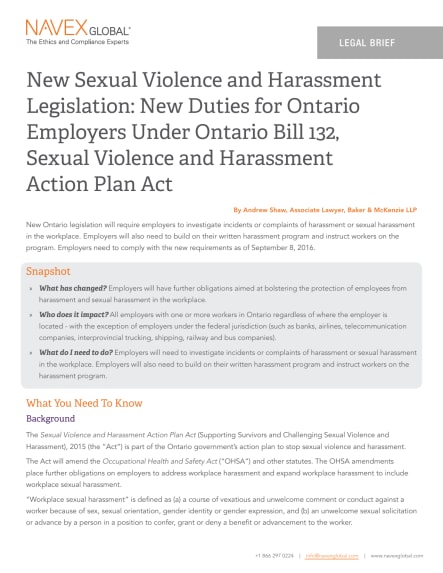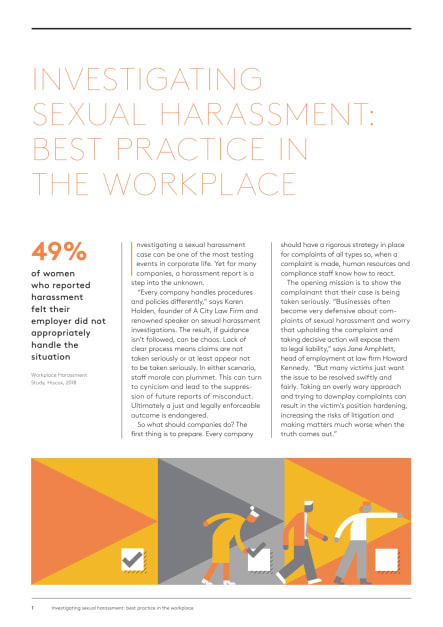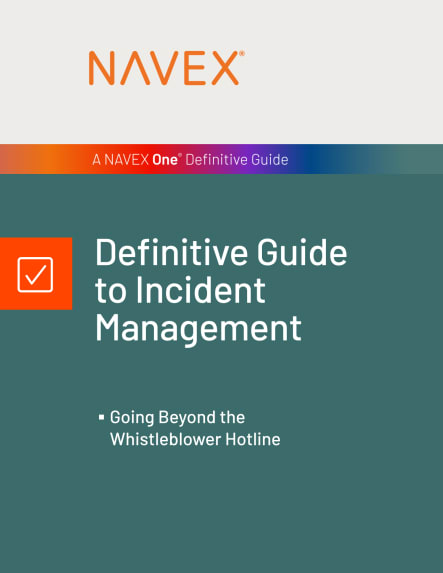About this Use case
New workplace harassment legislation in Ontario means any company with employees in the province need to make some changes. Learn what you need to know and do.
-
- This legislation applies to:
- Employers with one or more workers in Ontario, regardless of where the employer is located
-
- What you'll learn:
- What has changed with the new Ontario legislation
- Who the legislation impacts
- What employers need to do
-
- Page length:
- 3 pages
Read the Use case
New workplace harassment legislation in Ontario means any company with employees in the province need to make some changes. Learn what you need to know and do./h2>- - - - - -
**By Andrew Shaw, /strong>**Associate Lawyer, /strong>**Baker & McKenzie LLP/strong>/p>New Ontario legislation will require employers to investigate incidents or complaints of harassment or sexual harassment in the workplace. Employers will also need to build on their written harassment program and instruct workers on the program. Employers need to comply with the new requirements as of September 8, 2016./p>
**Snapshot/strong>/h3>- **What has changed?/strong> Employers will have further obligations aimed at bolstering the protection of employees from harassment and sexual harassment in the workplace./li>2. **Who does it impact? /strong>All employers with one or more workers in Ontario regardless of where the employer is located - with the exception of employers under the federal jurisdiction (such as banks, airlines, telecommunication companies, interprovincial trucking, shipping, railway and bus companies)./li>2. **What do I need to do?/strong> Employers will need to investigate incidents or complaints of harassment or sexual harassment in the workplace. Employers will also need to build on their written harassment program and instruct workers on the harassment program./li>/ul>### **What You Need To Know/strong>/h3>**Background/strong>/p>The *Sexual Violence and Harassment Action Plan Act/em> (Supporting Survivors and Challenging Sexual Violence and Harassment), 2015 (the “Act”) is part of the Ontario government’s action plan to stop sexual violence and harassment./p>The Act will amend the *Occupational Health and Safety Act /em>(“OHSA”) and other statutes. The OHSA amendments place further obligations on employers to address workplace harassment and expand workplace harassment to include workplace sexual harassment./p>“Workplace sexual harassment” is defined as (a) a course of vexatious and unwelcome comment or conduct against a worker because of sex, sexual orientation, gender identity or gender expression, and (b) an unwelcome sexual solicitation or advance by a person in a position to confer, grant or deny a benefit or advancement to the worker./p>
**New Duty to Investigate Incidents and Complaints/strong>/p>The OHSA amendments require the employer to investigate incidents or complaints of workplace harassment (including workplace sexual harassment). The investigation needs to be one "that is appropriate in the circumstances." The employer must inform the complainant and alleged harasser (if a worker) in writing of the investigation results and any corrective action./p>
No other guidance or requirements are stipulated as to how the employer should carry out or document the investigation; although the amendments provide that further duties may be prescribed./p>
An inspector appointed under the OHSA may order that an impartial third-party conduct an investigation at the employer’s expense. The inspector may also require that the third-party prepare a written report, also at the employer’s expense./p>
**New Requirements for the Harassment Program/strong>/p>Employers are currently required to have a written harassment policy and program in place. The OHSA amendments add new requirements for the program. The program covers how to implement the policy and, to comply with the amendments, will need to include:/p>
\- Measures and procedures for workers to report incidents of workplace harassment to the employer or supervisor (or another person if the employer or supervisor is the alleged harasser);/li>
\- How the employer will investigate and deal with incidents or complaints of workplace harassment;/li>
\- How information about an incident or complaint will not be disclosed (unless disclosure is necessary to the investigation or corrective action, or is otherwise required by law); and/li>
\- How a worker will be informed of the results of an investigation and any corrective action taken./li>/ul>The program must be developed in consultation with the joint health and safety committee or health and safety representative, if any. The program needs to be reviewed at least annually./p>
**New Duty to Instruct Workers on the Harassment Program/strong>/p>The OHSA amendments require the employer to provide a worker with "information and instruction that is appropriate for the worker on the contents of the policy and program with respect to workplace harassment."/p>
No other specifics for instructing workers are stipulated; although the amendments provide that additional information which the employer needs to provide to workers may be prescribed./p>
**Further Steps Recommended for Employers /strong>/p>In addition to meeting the new requirements in the OHSA amendments, it is recommended that employers take the following steps to support the employer in addressing, and lessening their exposure to, incidents or complaints of workplace harassment:/p>
\- Raise awareness among all staff (workers, managers and executives) about attitudes and behaviors that may cause offence to others and potentially constitute harassment;/li>
\- Train managers and executives on the employer's legal obligations with respect to preventing and addressing workplace harassment and sexual harassment, including new areas of protection, such as gender identity and gender expression; and/li>
\- Train human resources managers or other designated individuals on how to properly investigate an incident or complaint of harassment, including when to seek legal advice and the importance of maintaining confidentiality to the extent possible./li>/ul>### Get Help Complying With New Ontario Bill 132 Requirements/h3>
NAVEX offers the expertise and the tools you need to stay in compliance with the new requirements—from online compliance training and policy management to hotline and incident management solutions. Talk with a solutions expert today to make sure your organization is protected against risk of non-compliance. [Contact a NAVEX representative to learn more/a>. /p>### About the Author/h3>
**Andrew Shaw, /strong>**Associate Lawyer, /strong>**Baker & McKenzie LLP, Toronto/strong>: Andrew Shaw is a member of the firm’s Labour, Employment and Employee Benefits Group. He joined Baker & McKenzie LLP as an associate in 2010. Prior to attending law school, Mr. Shaw held labour relations positions at both private and public sector companies. In these roles, he managed the processing of grievances to an appropriate resolution, assisted internal clients with the interpretation of employment-related legislation, and provided counsel to senior management as required. While in law school, Mr. Shaw won the Koskie Minsky LLP prize in labour arbitration. Mr. Shaw advises and represents employers in matters regarding employment standards, labour arbitration, collective bargaining, human rights, wrongful dismissals and occupational health and safety. Andrew can be reached at [Andrew.Shaw@bakermckenzie.com/a>, or + 1 416 865 2303./p> /p>
/p>](/en-us/)******](/en-us/en-us/en-us/request-consultation-advisory-services-team-ontario-bill/)****************************

